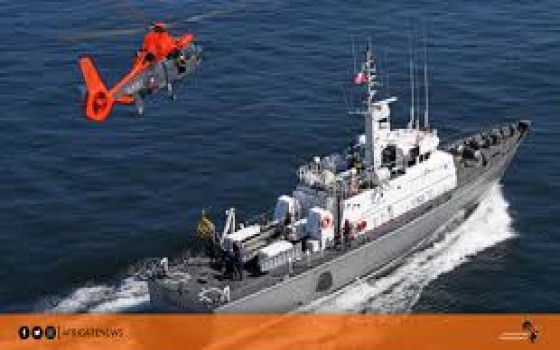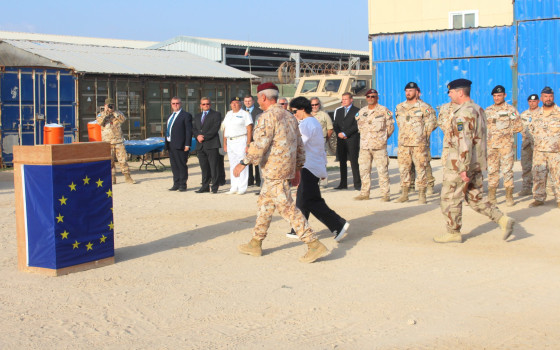European military plans to deal with the security situation in the Red Sea, the African Sahel region, and Ukraine

- Europe and Arabs
- Thursday , 1 February 2024 12:47 PM GMT
Brussels: Europe and the Arabs
European Union Foreign and Security Policy Coordinator Josep Borrell said after a meeting of ministers of member states informally hosted in Brussels on Wednesday, where the current rotating Belgian presidency of the Union is located. Borrell added, “I think it was one of the most intense, important, frank and open discussions that I had during my term.”
He added, "You know that maritime security in the Red Sea has deteriorated significantly over the past weeks."
We are developing a significantly new naval operation – which will be called ASPIDES, after the ancient Greek word for “shield.” It is a shield to operate purely defensively to protect merchant ships, and has two non-operational “escort” missions to deter with its presence and enhance maritime situational awareness.
They will be deployed at sea, with ships and air assets, commensurate with the threat we face. In this mission ASPIDES will not conduct any operation on land, but only at sea, in a purely defensive position.
Our goal is to create and launch this mission ASPIDES, at the latest on February 19th. I hope and I'm sure it will be so. we will. Member States are strongly committed to doing so. Not everyone will participate, but no one will hold them back.
We started the discussion about the Sahel region. There are major complications in the political and security situation. We must adapt our policies to the new reality. Mali, Niger and Burkina Faso have withdrawn from the Economic Community of West African States, and after Niger's junta abrogated legal agreements on the Common Security and Defense Policy (CSDP) missions last December, the military partnership mission with Niger left the country.
Preparations are underway for the withdrawal of our civilian mission, EUCAP in the Sahel region of Niger, by June this year.
Then, in the following days and meetings, we will make decisions on our military mission in Mali (EUTM Mali), since its mandate is coming to an end in May. We must coordinate the different approaches of different Member States on our strategic approach to the Sahel.
We will present a new country-by-country approach at the next Foreign Affairs Council in February, including commitment to our security and defense policies.
In another file, Borrell said, “We discussed our military support for Ukraine. I reiterated the urgent necessity - which is the key word - to agree on more military support in the short term, as well as in the long term, and we informed the Ukrainian Minister of Defense, Mr. Rustam Omerov, via a video message.” on the situation on the battlefield and briefed us on Ukraine's needs and priorities. It is important that today we share with Member States aggregate data of our support for Ukraine. Since the beginning of the Russian invasion - almost two years ago - the European Union and Member States have been together, and we have provided - and this number is very important - 28 billion Euros of military equipment so far. This is not a forecast, this is not a forecast, it is a fact. 28 billion euros of military support to Ukraine so far.
Then we asked member states about their commitments for this year, and I can say that at least 21 billion euros will be allocated in the 2024 budget for military assistance to Ukraine. You can see the acceleration. In one year - at least - 21 billion euros, compared to 28 billion euros in the first two years. It's bigger in one year than it was in two years.
And secondly, because there is another milestone, and I want to emphasize its importance, with our training mission [EUMAM Ukraine]. We have almost reached the goal of training 40,000 Ukrainian soldiers through our training mission in Ukraine. Today, we have agreed to add an additional 20,000 soldiers, bringing the total number to 60,000 soldiers trained. This number – 60,000 – will be reached by the end of the summer. And you know that good training means saving lives on the battlefield.
We then discussed in depth about our munitions initiative. Here I want to clarify things. I hope to provide you with specific and accurate information [about] production capacity, production and those [provided] to Ukraine. Last year, the European Union and Member States committed to delivering one million artillery shells to Ukraine within one year.
Based on the latest information from Member States - and I stress again that these numbers are evolving daily, and not all Member States have actually sent their inputs, but with the overall picture at that moment - I can say that, from last March until now - the beginning of this year - We delivered 330,000 rounds of ammunition. So, [we achieved] about a third of the target, mainly taken from our inventories, from existing inventories.
By March I expect this number to rise by another 200,000, to 524,000. It's a little bit more - [so] 52% of the target. This comes through unloading, individual and joint purchases.
But this is a work in progress. The whole mechanism here in the European defense industry is working and the member states are giving orders.
By the end of the year, deliveries of the plan will reach more than one million
This is the picture I currently have of deliveries made or planned – and I insist it changes every day. It is developing and increasing, and will continue to increase. The situation will continue to improve in the coming months.
Regarding production capacity, Borrell said, “Internal Market Commissioner Thierry Breton and the European Defense Agency checked the level of production capacity. The good news is that production capacity has increased by 40% since the beginning of the war. We were at a very low level for our [defense] technological and industrial base. And it's increasing. We have to keep increasing, but 40% is too much.
Today's ammunition production capacity is approximately 1 million ammunition per year.














No Comments Found